Welcome to the first edition of First Nations News & Views. This weekly series is one element in the “Invisible Indians” project put together by navajo and me, with assistance from the Native American Netroots Group. Each Sunday’s edition will include a short, original feature article, a look at some date relevant to American Indian history, and some briefs chosen to show the diversity of modern Indians living both on and off reservations in the United States and Canada.
“The buffalo are disappearing rapidly, but not faster than I desire. I regard the destruction of such game as Indians subsist upon as facilitating the policy of the Government, of destroying their hunting habits, coercing them on reservations, and compelling them to begin to adopt the habits of civilization.”
– Secretary of the Interior Columbus Delano, Testimony to Congress, 1874
“We recognize the bison is a symbol of our strength and unity, and that as we bring our herds back to health, we will also bring our people back to health.”
– Fred DuBray, former president Inter Tribal Buffalo Council, 2005
By 1870, the great herds of buffalo, or American Bison, that had in the 1500s roamed everywhere except present-day New England, were limited to 11 Western states and territories. There were still millions of them, perhaps 40 million. The massive slaughter that began in earnest in 1874 ended nine years later. By 1890, only 500 bison remained, and the devastated, decimated tribes who had depended on them were confined to reservations and a hard-scrabble existence.
Today, however, there are around 500,000 fenced bison in commercial herds, many of them genetically intermixed with cattle breeds and sold for meat domestically and abroad. There are also some 20,000 genetically pure bison in free-roaming herds, like the 3000 in Yellowstone National Park. The biggest fenced herds are in Nebraska, Colorado, North Dakota, and South Dakota, the leader, where there are about 40,000 head of bison on private ranches and tribal land.
As NPR reported early last year, the demand for bison meat is rising, and not just for burgers. And the demand in 2011 kept up the pace.
“Five years ago, I spent 90 percent of my time trying to get people to eat bison. Now, I spend 90 percent of my time getting people to raise bison,” said Dave Carter, executive director of the Westminster-based National Bison Association.
Among the bison raisers are the 56 tribes of the non-profit Inter Tribal Buffalo Council, which got its start in 1990. Some tribes started as early as 1971 to reintroduce bison and, collectively, they now have herds totaling about 15,000 head in 19 states. The idea behind this is far more than economic. As the ITBC web site states, the “reintroduction of the buffalo to tribal lands will help heal the spirit of both the Indian people and the buffalo.” For Indians of the Plains and far beyond, the bison was woven into every aspect of their lives and was an integral part of their philosophy and religion.
ITBC Cultural Education Coordinator Carla Rae Brings Plenty (Lakota-Cheyenne River) recently wrote:
[The council] is committed to reestablishing bison herds on Indian lands in a manner that promotes cultural enhancement, spiritual revitalization, ecological restoration, and economic development. ITBC is governed by a Board of Directors, comprised of one tribal representative from each member tribe.
The role of the ITBC, as established by its membership, is to act as a facilitator in coordinating education and training programs, develop marketing strategies, coordinate the transfer of surplus American buffalo – also known as bison – from national parks to tribal lands, and provide technical assistance to its membership. The ITBC works collaboratively with members to develop sound management plans that enable tribal herds to become successful and self-sufficient operations.
Among other reasons for restoring the bison herds is some hope for change in the diet of many Indians, on and off the reservation, who have high rates of obesity, diabetes and heart disease as consequence of both poverty and a poor understanding of nutrition. Bison meat is extremely lean, with less than a third the amount of fat and cholesterol and less than two-thirds as many calories as beef. It also has more iron an vitamin B12 than beef. But it is a very long way from providing more than an occasional meal on any of the reservations.
The process of restoration is slow, but growth in tribal herds steadily continues. In early December, the Montana Fish, Wildlife and Parks Commission approved the removal of 68 quarantined bison to the reservations at Fort Belknap (A’aninin-Gros Ventre and the Nakota-Assiniboine) and Fort Peck (Assiniboine-Sioux). About 700 now graze at Fort Belknap and another 200 can be found Turtle Mound Buffalo Ranch on the Fort Peck reservation.
 |
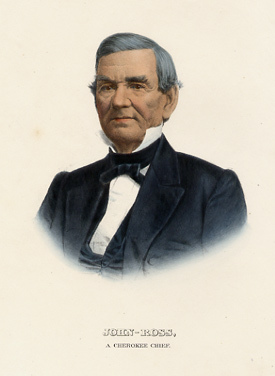
This Week in American Indian History in 1833:
It can be said that the non-violent resistance campaign by the Cherokee nation against removal and relocation to Indian Territory (now Oklahoma) began on Jan. 28, 1833. Tribal leaders, including John Ross, the principal chief of the Eastern Cherokee, met that day with Secretary of War John Eaton to say they would not negotiate with the federal government about removal because Washington was not living up to previous agreements to protect them since gold had been discovered on Cherokee land in 1829. Murderous white “pony clubs,” a kind of pre-Civil War Ku Klux Klan killed Cherokee men, raped Cherokee women and burned their houses and entire towns, allowing whites to stake mining claims. The Cherokee delegation in Washington had reason to be worried because President Andrew Jackson, was no friend, having betrayed the Cherokee by forcing the cession of more than 2 million acres of their land after the Red Stick War ended in 1814 even though they had allied themselves with the federal government against the rebellious wing of the Creek tribe in that conflict. Moreover, as soon as gold had been discovered in 1829, Jackson had removed all federal troops from Georgia and let state authorities and the ad hoc “pony clubs” to act they wished.
Eaton told them their only hope was removal. Jackson offered the Eastern Cherokee $3 million for all their lands east of the Mississippi except those in North Carolina if they would move. The delegation said the illegal Georgia gold mines alone were worth more than that. Thus began a five-year effort of sophisticated non-violent resistance which appealed to both moral and political authority. Ultimately, it failed and 16,000 Cherokee were removed across the Mississippi, at least 4,000 of their number dying along what is now known as the “Trail of Tears.”
 |
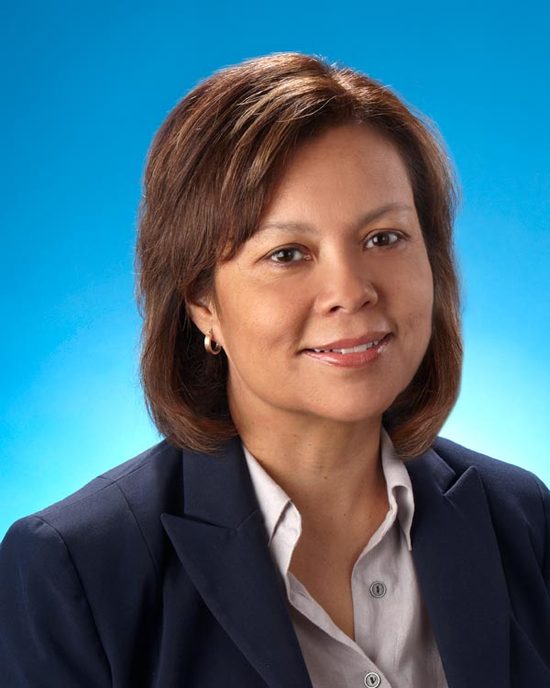
Susan Allen (Sicangu-Oglala Lakota) Wins Seat in Minnesota Legislature
Susan Allen of the Democratic-Farmer-Labor Party won a special election for district 61B seat of the Minnesota House of Representatives on Jan. 10. The race was notable because Allen, an enrolled member of the Rosebud Sioux tribe, is the first lesbian American Indian elected to any state legislature. The impoverished district in south-central Minneapolis has many problems with which Allen is familiar. She was born on the Uintah and Ouray Ute reservation in northeastern Utah, moved around to many reservations as a young girl because her Oglala Lakota father was an episcopal priest. She saw much social and economic injustice, which has played a major role in determining her political views.
She says she will focus on investing in jobs, education, tax reform, as well as creating a single-payer health care system, preserving the environment, and saying no to the anti-gay marriage amendment on the state ballot next November. “We’re thrilled for Susan and the remarkable progress her victory represents,” said Tiffany Muller, vice president for political operations for the Victory Fund. “This is our first win of 2012, and it’s a fantastic way to start off what will be a very exciting year for LGBT candidates.”
 |
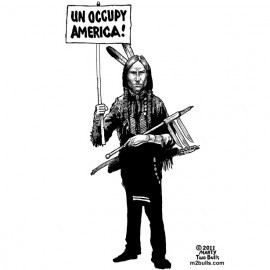
U.S. Supreme Court Takes Indian Casino Case
The U.S. Supreme Court will hear arguments on two petitions related to a decision by the federal government to take the Bradley Tract, a parcel of Pottawatomi-owned land in Michigan, into trust. The petitions were brought by Interior Secretary Kenneth Salazar and by the Match-E-Be-Nash-She-Wish Band, also known as the Gun Lake Tribe, which seeks to have the land taken into trust so they can build a casino on it. David Patchak, a private individual who lives near the land in question, filed a complaint alleging that a casino would destroy the peace and quiet of the area and create pollution. The tribe won a judgment in U.S. District Court on the grounds that Patchak had no “prudential” interest in the case. But the Circuit Court of Appeals overturned that decision. The case may boil down to an interpretation of whether putting the land into trust can be done by the Interior Department for tribes that were not yet recognized by the federal government in 1934 at the time of the Indian Reorganization Act. The Match-E-Be-Nash-She-Wish Band did not receive federal recognition until 1998.
 |
Maryland recognizes the Piscataways
After years of struggle and appeals, as well as an internal schism, the Piscataway tribe of southern Maryland has gained state recognition. The tribe’s ancestors have lived in the area for as much as 12 millennia. But Maryland officials previously said documentation connecting today’s Piscataways with Indians dating back before 1790 was inadequate for recognition and had rejected their applications. One motivation behind the rejection was the view of some citizens that the tribe is only interested in recognition so they could build casinos. The Piscataways, of whom there are now about 5,000, renounced any right to casinos in the negotiations to get recognition.
Mervin Savoy, the 68-year-old chairwoman of the Piscataway-Conoy Confederacy, had waited a long time for the day Democratic Gov. Martin O’Malley to make the recognition official.
“A reporter once asked me what it felt like to be an Indian,” Savoy says, laughing. “You might as well ask me what it feels like to be a woman. I don’t know; I’ve never been anything else.”
Savoy didn’t see anything unusual in the way her grandparents lived off the land. Her grandmother picked mint and peach leaves to flavor food. For a headache, she prescribed bark from a weeping willow tree. For a bee sting, she rubbed the irritated skin with three types of grass.
“All of these things, you could just walk out to the yard and get,” Savoy says.
The struggle for federal recognition, which would provide the Piscataways with funds for education, housing and public health, continues.
-News & Views h/t to Bill in MD
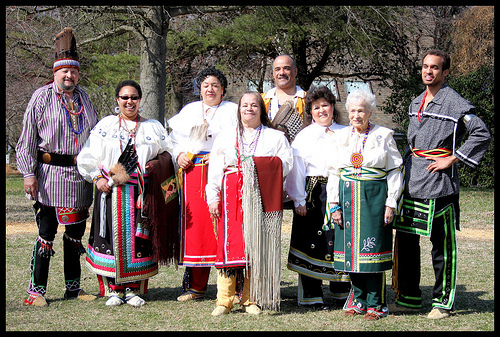 |
| Piscataways in traditional cloth regalia. Left to Right: Piscataway Tribal Spokesman Rico Newman, Diona Kakinohana, Desiree Windsor, Provisional Tribal Council Chairwoman Mervin Savoy, MCIA Vice Chair Thomas Windsor, Linda Proctor, Argentine Newman, Piscataway Communications Director Chris Newman (Photo courtesy of Shikya Wilson) |
 |
Do Congress and Obama Really Support the Tribal Law and Order Act?
The 2010 passage and signing of the Tribal Law and Order Act was viewed by many Indians as a major step forward and the keeping of one of the promises made by the Obama administration to pay attention to Indian voices about our needs. But, as Rob Capriccioso reports, TLOA is being undermined by budget cuts and an apparent lack of seriousness in pursuing key aspects of the legislation. In November $90 million was cut from the Department of Justice’s programs. “There continues to be a public safety crisis on our Indian reservations, and the lives of women and children are in danger every day,” said retired Sen. Byron Dorgan (D-ND), a key promoter of the TLOA when he chaired the U.S. Senate Committee on Indian Affairs.
“Unlike other areas of government spending, the federal government has a distinct legal, treaty, and trust obligation to provide for the public safety of Indian country,” wrote [Ryan] Dreveskracht, a lawyer with the Galanda Broadman Indian-focused law firm in an article posted on his firm’s web site. … This obligation was made explicit in section 202 of the TLOA and was thoroughly discussed in the congressional record. That that same Congress is absolutely ignoring those duties now makes it that much worse. As a result, people are literally dying,” Dreveskracht added. “While crime outside Indian reservations has declined in recent years, the violent crime rate in Indian country has increased dramatically over the same time period – with homicides increasing by 14 percent in just four years.”
 |
Wisconsin Fights Suit Over Law Banning Indian Mascots
The state of Wisconsin wants the courts to dismiss a challenge to the constitutionality of a 2010 law that allows the state school superintendent to ban American Indian mascots and logos. The Department of Public Instruction ordered the Berlin School District to drop its “Indians” nickname and logo by Sept. 16, 2012, because its promotes stereotyping, discrimination and pupil harassment. The state had received a complaint from a district resident regarding the Berlin Indians’ nickname. The state also plans to appeal the decision of a judge to overturn his ruling rejecting a previous DPI order that the Mukwonago High School ditch its mascot and the “Indians” name of its athletic teams. That judge called the law, Act 250, “uncommonly silly.” It was passed when Democrats controlled the legislature. Republicans are now in charge, and some seek to repeal the law.
Barbara Munson (Oneida) chairs the Wisconsin Indian Education Association’s Indian Mascot and Logo Taskforce. She says 33 of the 65 Wisconsin schools with Indian-related team names have dropped them, or changed their logos since 1994. That was the year Marquette University dropped its Warriors team name and mascot and became the Golden Eagles. Wisconsin’s 11 tribes, through their Great Lakes Inter-Tribal Council, are on record opposing the names. “These images are archaic,” she says, and “should have left our culture as a whole along with Sambo’s restaurants (and) blackface minstrel shows.”
 |
Saginaw Chippewa Tribe Holds Repatriation Ceremony
The Michigan Anishinaabek Cultural Preservation and Repatriation Alliance and the Saginaw Chippewa Indian Tribe of Michigan held a repatriation and reburial ceremony at its Nibokaan Ancestral Cemetery Dec. 19. The remains of an indigenous woman who died before the arrival of Europeans but was dug up in 1905 and wound up in the Museum of Vancouver, BC, were buried along with 256 funerary items.
Nibokaan was established in Mt. Pleasant, Mich., in 1995 specifically for the purpose of reburying indigenous ancestors. Such repatriations were made more possible by the Native American Graves Protection and Repatriation Act of 1990. From the time of the tribe’s initial request until reburial, such repatriations 10 years or more. Fourteen months ago, the Saginaw Chippewa reburied the remains of 144 indigenous individuals who had been dug up in the 1960s by Central Michigan University for use as a teaching tool for its archaeological program. The bodies had been placed in a storage room ever since.
 |
Tohono O’odham Shadow Wolves Patrol Border for Drug Contraband
The Shadow Wolves is an elite force that patrols the Arizona-Mexico border and uses traditional tracking methods to find drug smugglers and their goods. The force comprises nine members of the Tohono O’odham tribe, whose 28,000 members have the second largest tribal land base in the United States. The technique used is known as “cutting for sign.” It is taught from childhood, says one of the wolves, Jason Garcia: “This takes a lot of patience. You’re looking for something that’s almost invisible.”
A reporter traveling was astonished when Garcia told him from looking at the signs that the quarry they were hunting “had passed by only minutes before in an SUV, probably a Chevrolet, heading directly north towards Phoenix 100 miles away.”
 |
A new group has launched a web site, The Last Real Indians, readers may find to their liking. Here’s an excerpt from one of the team of five writers, Ruth Hopkins (Sisseton Wahpeton/Mdwakanton/Hunkpapa), whose tribal enrollment is at the Standing Rock Sioux Reservation:
Indigenous peoples are always on the precipice, so it should come as no surprise that we are making good use of social media and the blogosphere as well. Facebook helped The Indigenous Environmental Network mobilize American Indian and First Nation citizens to protest against fracking on Tribal lands, and the Keystone XL pipeline. If implemented, the pipeline would transport toxic fossil fuel from Canadian Tar Sands to the Gulf of Mexico- traveling directly through the Ogallala aquifer, the source of pure drinking water for millions. Buffalo Nickel Creative (BNC3) and its affiliate, the 1491s, is an indigenous social media powerhouse.
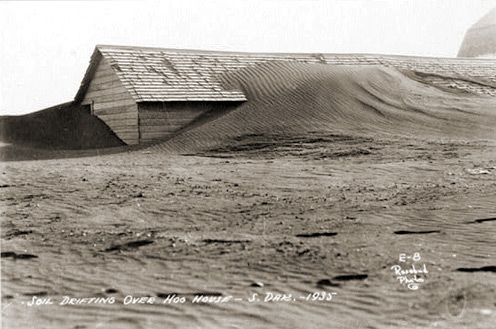
What are you reading about in the news on American Indians?